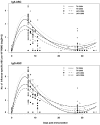Influence of prior influenza vaccination on antibody and B-cell responses
- PMID: 18714352
- PMCID: PMC2500171
- DOI: 10.1371/journal.pone.0002975
Influence of prior influenza vaccination on antibody and B-cell responses
Abstract
Currently two vaccines, trivalent inactivated influenza vaccine (TIV) and live attenuated influenza vaccine (LAIV), are licensed in the USA. Despite previous studies on immune responses induced by these two vaccines, a comparative study of the influence of prior influenza vaccination on serum antibody and B-cell responses to new LAIV or TIV vaccination has not been reported. During the 2005/6 influenza season, we quantified the serum antibody and B-cell responses to LAIV or TIV in adults with differing influenza vaccination histories in the prior year: LAIV, TIV, or neither. Blood samples were collected on days 0, 7-9 and 21-35 after immunization and used for serum HAI assay and B-cell assays. Total and influenza-specific circulating IgG and IgA antibody secreting cells (ASC) in PBMC were detected by direct ELISPOT assay. Memory B cells were also tested by ELISPOT after polyclonal stimulation of PBMC in vitro. Serum antibody, effector, and memory B-cell responses were greater in TIV recipients than LAIV recipients. Prior year TIV recipients had significantly higher baseline HAI titers, but lower HAI response after vaccination with either TIV or LAIV, and lower IgA ASC response after vaccination with TIV than prior year LAIV or no vaccination recipients. Lower levels of baseline HAI titer were associated with a greater fold-increase of HAI titer and ASC number after vaccination, which also differed by type of vaccine. Our findings suggest that the type of vaccine received in the prior year affects the serum antibody and the B-cell responses to subsequent vaccination. In particular, prior year TIV vaccination is associated with sustained higher HAI titer one year later but lower antibody response to new LAIV or TIV vaccination, and a lower effector B-cell response to new TIV but not LAIV vaccination.
Conflict of interest statement
Figures




References
-
- Thompson WW, Shay DK, Weintraub E, Brammer L, Bridges CB, et al. Influenza-Associated Hospitalizations in the United States. JAMA. 2004;292:1333–1340. - PubMed
-
- CDC CfDCaP. Update: Influenza activity–United States and worldwide, 2004–05 season. MMWR Morb Mortal Wkly Rep. 2005;54:631–634. - PubMed
-
- CDC CfDCaP. Update: influenza activity–United States and worldwide, 2003–04 season, and composition of the 2004–05 influenza vaccine. MMWR Morb Mortal Wkly Rep. 2004;53:547–552. - PubMed
-
- Nichol KL, Mallon KP, Mendelman PM. Cost benefit of influenza vaccination in healthy, working adults: an economic analysis based on the results of a clinical trial of trivalent live attenuated influenza virus vaccine. Vaccine. 2003;21:2207–2217. - PubMed
MeSH terms
Substances
LinkOut - more resources
Full Text Sources
Other Literature Sources
Medical
Miscellaneous

